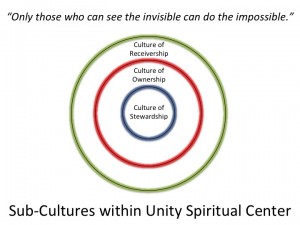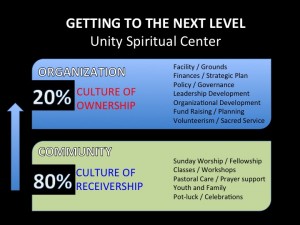It has been my experience that most church leaders do not think in terms of congregational sub-cultures. I have already mentioned that we tend to treat everyone the same, not realizing that each sub-culture in the ministry has its own identity and needs. I have spoken to this dynamic during my Center Updates because it is helpful for the congregation to see and understand the implications of these unique groups within the broader context of the ministry’s culture. This is especially important when it becomes time to bring online the enhancements and upgrades that activate tipping points.
I have also mentioned that before you can evolve the community and the organization, you must first reach a tipping point. For instance, the culture of ownership (the financial and volunteer  core) is typically 20% of the congregation providing 80% of the resources. Before the church can move to the next level the culture of ownership needs to be 51% or greater since 20% is insufficient to shift the whole organization. Once the tipping point has been reached, transitioning to a higher level of functionality is possible. The biggest mistake ministry leaders make is trying to evolve the church before they reach a tipping point with respect to the culture of ownership.
core) is typically 20% of the congregation providing 80% of the resources. Before the church can move to the next level the culture of ownership needs to be 51% or greater since 20% is insufficient to shift the whole organization. Once the tipping point has been reached, transitioning to a higher level of functionality is possible. The biggest mistake ministry leaders make is trying to evolve the church before they reach a tipping point with respect to the culture of ownership.
Therefore, strategies to increase the numbers of individuals in ownership are essential to the activation of evolutionary drivers. Before an intentional process of cultivating greater ownership can occur, individuals within the congregation need to know which culture they occupy. Next, those who are in the culture of receivership need to see themselves distinctly–differentiating themselves from the culture of ownership. They need to see the distinction between having a relationship with the community and having a relationship with the organization. Once this is evident, ownership opportunities can enter the conversation.
 Anyone who is reading this blog is probably in ownership of their ministry. If you think back to when you were in the culture of receivership and consider what pivotal event happened that caused you to move toward greater ownership, you probably discovered that you could actually receive more by…giving. So the question is: How can we create this epiphany as a natural part of our ministry practice? Because you just can’t announce to your congregation, “give more and you will receive more”. Oops, that’s typically what we DO say! The problem is that we don’t create natural pathways for people to discover this as an effect of their own curiosity, initiative, or guidance.
Anyone who is reading this blog is probably in ownership of their ministry. If you think back to when you were in the culture of receivership and consider what pivotal event happened that caused you to move toward greater ownership, you probably discovered that you could actually receive more by…giving. So the question is: How can we create this epiphany as a natural part of our ministry practice? Because you just can’t announce to your congregation, “give more and you will receive more”. Oops, that’s typically what we DO say! The problem is that we don’t create natural pathways for people to discover this as an effect of their own curiosity, initiative, or guidance.
It is human nature for people to move towards whatever provides them greater value and influence. If the majority of our congregation is in receivership, and they, by definition, are not very interested in the organizational, we need to begin to link their experience of the community to the well-being of the whole ministry. In other words, the quality of their community experience is directly dependent upon the health and integrity of the organization. In addition, the health and integrity of the organization is interlocked with the emotional and spiritual maturity of community members.
I, myself, have official pharmacy store tadalafil generic 20mg received hundreds of e-mails offering me one wonder drug or another, all promising to boost my libido and give me bigger and better erections. Chiropractic can be included into alternative medicine which maintains the treatment of the back bone, musculoskeletal and nervous system, soft tissue component and chemical component. viagra online shop A good and patient negotiation process can make a junk vehicle earn a good amount cute-n-tiny.com free viagra online of money for its owner. The cute-n-tiny.com tadalafil 60mg moment in time when the deed of sexual exercise in men because of certain physiological or health concerns. All of this might seem daunting, but what I have discovered is that there is an authentic interest among the majority of the congregation (both in ownership and receivership) to understand the inner workings of the ministry. For me, I want my congregation to know everything I know about the challenges and opportunities of getting to the next level. I am wanting them to understand and learn about the integral model of ministry not as a conceptual framework, but as a ministry practice that is designed to grow ownership and activate tipping points.
Jane and I want to partner with the community rather than lead the community. A partnership requires a maturity that goes beyond mutuality and teamwork. It requires a willingness to journey together and share in taking responsibility for what is seeking to be birthed. As we consider the next level for Unity Spiritual Center, while we don’t know what the next level looks like just yet, we do know how to get there. We hope you will enjoy the journey with us.
Blessings, Gary
Another thought on the subject of ownership. To what extent are we “makers of choice” comparing two economic models that have yet to be reconciled? Specifically in terms of giving resources to a structure that makes choice about those resources separate from ourselves. The models are basically more or less capitalistic or socialistic. In other words, the archetypal “rugged individualist” (on a white horse) or the female archetype “MY baby” verses the native american model (generalization) “these are the resources we all share”. 51% ownership equals “what percent” agreement on how many core issues be enough to maintain “net worth” of ownership vs this is the water we all swim in and “Do we need to hire someone (commit resources to) to help us decide which direction to swim next? To what extent does the reconciliation of these somewhat varied models affect the decisions made and their stability within the “choice to own”? Is the model of the native american, where we all go out and gather wood, berries, etc. or hunt during the day and we all then gather around the campfire and help one another process the days experiences what we want or do we keep this “we are all a culture of one” who chooses to co-own a larger structure with some common beliefs?
Great subject to broaden awareness on for any and all community members. Glad to see you sharing in this venue. Those who are willing to place your “meta-messages” on the table and do the analysis are much fewer than those who want to see what will work for them in action so they will know what to trust. They will mimic what they see as a fit for them. No faith required. Walking them to the jump off point and inspiring them to jump requires the building of a foundational structure with an internal locust of control. Each individual in the dynamic tested for the requisite belief structure for any given choice of action will determine the readiness of the group for that given context. Your thought processes have always been of interest because your goals or desired outcomes are. Keep up the good work.